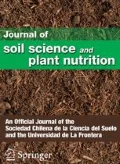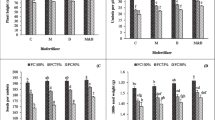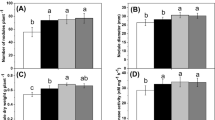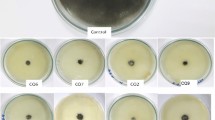Abstract
Crop inoculation with plant growth-promoting rhizobacteria (PGPR) is a sustainable alternative to diminish the excessive use of chemical fertilizers in agriculture. However, there is little information about PGPR inoculation effects under field conditions and even less on industrial tomato production. We aimed to study the effects of a sole inoculation at seedling stage with Pseudomonas fluorescens Rt6M10, Azospirillum brasilense Az39, and their combination on growth and yield of two industrial tomato varieties UCO 14 (UCO) and Harris Moran 3861 (HM). We compared these PGPR inoculation treatments with chemically fertilized and non-fertilized (control) seedlings under field conditions. We found that inoculation with Rt6M10, Az39, and their combination increased seedling root dry weight by 62%, 41%, and 23%, respectively and shoot dry weight by 29%, 23%, and 2%, respectively compared with non-inoculated control, improving tolerance to transplant stress. Inoculation with Rt6M10, Az39, and their combination increased stem diameter by 15%, 16%, and 13%, respectively, while Rt6M10 and the combination treatments increased leaf chlorophyll and carotenoid levels compared with non-inoculated plants. Az39 increased fruit number (35%) and fruit weight (38%) per plant in HM, whereas in UCO variety, the increase was the highest (48% and 49%, respectively). Seedling inoculation increase fruit firmness and equatorial and polar fruit diameter by 24%, 10%, and 12%, respectively in HM and by 21%, 14%, and 14%, respectively in UCO. Overall, bio-inoculation with Rt6M10 and/or Az39 was beneficial for tomato seedlings at transplanting and supported fruit yield and quality (total soluble solid content, pH, and titratable acidity) equally or better than chemically fertilized seedlings.



Similar content being viewed by others
References
Adesemoye AO, Torbert HA, Kloepper JW (2008) Enhanced plant nutrient use efficiency with PGPR and AMF in an integrated nutrient management system. Can J Microbiol 54:876–886
Adesemoye AO, Torbert HA, Kloepper JW (2009) Plant growth-promoting rhizobacteria allow reduced application rates of chemical fertilizers. Microb Ecol 58:921–929
Ahmed M, Rauf M, Mukhtar Z (2017) Excessive use of nitrogenous fertilizers: an unawareness causing serious threats to environment and human health. Environ Sci Pollut Res 24:26983–26987
Amirnia R, Ghiyasi M, Moghaddam SS, Rahimi A, Damalas CA, Heydarzadeh S (2019) Nitrogen-fixing soil bacteria plus mycorrhizal fungi improve seed yield and quality traits of lentil (Lens culinaris Medik). J Soil Sci Plant Nutr 19:592–602
Argerich CA, Smith P (2018) Asociación Tomate 2000. Programa para el aumento de la competitividad de la industria del tomate. Informe Progresos 2017-2018. Cosme A. Argerich y Patrick Smith, Ed. La Consulta, INTA EEA La Consulta. 2018. https://inta.gob.ar/documentos/asociacion-tomate-2000-programa-de-competitividad-de-la-industria-de-tomate-informe-de-progresos-2017-2018. Accessed 18 Mar 2019
Bhardwaj D, Ansari MW, Sahoo RK, Tuteja N (2014) Biofertilizers function as key player in sustainable agriculture by improving soil fertility, plant tolerance and crop productivity. Microb Cell Factories 13:66
Bona E, Cantamessa S, Massa N, Manassero P, Marsano F, Copetta A, Lingua G, D'Agostino G, Gamalero E, Berta G (2017) Arbuscular mycorrhizal fungi and plant growth-promoting pseudomonads improve yield, quality and nutritional value of tomato: a field study. Mycorrhiza 27:1–11
Bona E, Todeschini V, Cantamessa S, Cesaro P, Copetta A, Lingua G, Berta G, Massa N (2018) Combined bacterial and mycorrhizal inocula improve tomato quality at reduced fertilization. Sci Hortic 234:160–165
Bottini R, Cassán F, Piccoli P (2004) Gibberellin production by bacteria and its involvement in plant growth promotion and yield increase. Appl Microbiol Biotechnol 65:497–503
Carrari F, Fernie AR (2006) Metabolic regulation underlying tomato fruit development. J Exp Bot 57(9):1883–1897
Cohen AC, Travaglia CN, Bottini R, Piccoli PN (2009) Participation of abscisic acid and gibberellins produced by endophytic Azospirillum in the alleviation of drought effects in maize. Botany 87:455–462
Cohen AC, Bottini R, Pontin M, Berli FJ, Moreno D, Boccanlandro H, Travaglia CN, Piccoli PN (2015) Azospirillum brasilense ameliorates the response of Arabidopsis thaliana to drought mainly via enhancement of ABA levels. Physiol Plant 153:79–90
Cordero I, Balaguer L, Rincón A, Pueyo JJ (2018) Inoculation of tomato plants with selected PGPR represents a feasible alternative to chemical fertilization under salt stress. J Plant Nutr Soil Sci 181:694–703
Couillerot O, Ramírez-Trujillo A, Walker V, von Felten A, Jansa J, Maurhofer M, Défago G, Prigent-Combaret C, Comte G, Caballero-Mellado J, Moënne-Loccoz Y (2013) Comparison of prominent Azospirillum strains in Azospirillum–Pseudomonas–Glomus consortia for promotion of maize growth. Appl Microbiol Biotechnol 97(10):4639–4649
Damalas CA, Eleftherohorinos IG (2011) Pesticide exposure, safety issues, and risk assessment indicators. Int J Environ Res Public Health 8:1402–1419
Dawwam GE, Elbeltagy A, Emara HM, Abbas IH, Hassan MM (2013) Beneficial effect of plant growth promoting bacteria isolated from the roots of potato plant. Ann Agric Crop Sci 58:195–201
García de Salamone IE, Funes JM, Di Salvo LP, Escobar-Ortega JS, D’Auria F, Ferrando L, Fernandez-Scavino A (2012) Inoculation of paddy rice with Azospirillum brasilense and Pseudomonas fluorescens: impact of plant genotypes on rhizosphere microbial communities and field crop production. Appl Soil Ecol 61:196–204
García JE, Maroniche G, Creus C, Suárez-Rodríguez R, Ramirez-Trujillo JA, Groppa MD (2017) In vitro PGPR properties and osmotic tolerance of different Azospirillum native strains and their effects on growth of maize under drought stress. Microbiol Res 202:21–29
García JAL, Probanza A, Ramos B, Palomino M, Mañero FJG (2004) Effect of inoculation of Bacillus licheniformis on tomato and pepper. Agronomie 24:169–176
Glick BR (2012) Plant growth-promoting bacteria: mechanisms and applications. Scientifica 2012:963401
Glick BR (2014) Bacteria with ACC deaminase can promote plant growth and help to feed the world. Microbiol Res 169:30–39
Gómez PA, Camelo AFL (2002) Calidad postcosecha de tomates almacenados en atmósferas controladas. Hortic Bras 20:38–43
Gravel V, Antoun H, Tweddell RJ (2007) Growth stimulation and fruit yield improvement of greenhouse tomato plants by inoculation with Pseudomonas putida or Trichoderma atroviride: possible role of indole acetic acid (IAA). Soil Biol Biochem 39:1968–1977
Gyaneshwar P, Kumar GN, Parekh LJ, Poole PS (2002) Role of soil microorganisms in improving P nutrition of plants. Plant Soil 245:83–93
Ijaz M, Tahir M, Shahid M, Ul-Allah S, Sattar A, Sher A, Mahmood K, Hussain M (2019) Combined application of biochar and PGPR consortia for sustainable production of wheat under semiarid conditions with a reduced dose of synthetic fertilizer. Braz J Microbiol 50:449–458
Ijaz M, Perveen S, Nawaz A, Ul-Allah S, Sattar A, Sher A et al (2020) Eco-friendly alternatives to synthetic fertilizers for maximizing peanut (Arachis hypogea L.) production under arid regions in Punjab, Pakistan. J Plant Nutr 43:762–772
Jackson ML (1973) Soil chemical analysis. Prentice Hall (India) Pvt. Ltd., New Delhi
Jewell MC, Campbell BC, Godwin ID (2010) Transgenic plants for abiotic stress resistance. In: In Transgenic crop plants. Springer, Berlin, Heidelberg, pp 67–132
Kokalis-Burelle N, Vavrina CS, Rosskopf EN, Shelby RA (2002) Field evaluation of plant growth-promoting rhizobacteria amended transplant mixes and soil solarization for tomato and pepper production in Florida. Plant Soil 238:257–266
Kokalis-Burelle N, Kloepper JW, Reddy MS (2006) Plant growth-promoting rhizobacteria as transplant amendments and their effects on indigenous rhizosphere microorganisms. Appl Soil Ecol 31:91–100
Martínez OA, Encina C, Tomckowiack C, Droppelmann F, Jara R, Maldonado C, Muñoz O, García-Fraile P, Rivas R (2018) Serratia strains isolated from the rhizosphere of raulí (Nothofagus alpina) in volcanic soils harbour PGPR mechanisms and promote raulí plantlet growth. J Soil Sci Plant Nutr 18:804–819
Mena-Violante HG, Olalde-Portugal V (2007) Alteration of tomato fruit quality by root inoculation with plant growth-promoting rhizobacteria (PGPR): Bacillus subtilis BEB-13bs. Sci Hortic 113:103–106
Mena-Violante HG, Cruz-Hernández A, Paredes-López O, Gómez-Lim MÁ, Olalde-Portugal V (2009) Fruit texture related changes and enhanced shelf-life through tomato root inoculation with Bacillus subtilis BEB-13BS. Agrociencia 43:559–567
Moreno D, Berli F, Piccoli P, Bottini R (2011) Gibberellins and abscisic acid promote carbon allocation in roots and berries of grapevines. Plant Growth Regul 30:220–228
Murcia G, Fontana A, Pontin M, Baraldi R, Bertazza G, Piccoli PN (2017) ABA and GA3 regulate the synthesis of primary and secondary metabolites related to alleviation from biotic and abiotic stresses in grapevine. Phytochem 135:34–52
Nelson DW, Sommers LE (1973) Determination of total nitrogen in plant material. Agron J 65:109–112
Nzanza B, Marais D, Soundy P (2012) Response of tomato (Solanum Lycopersicum L.) to nursery inoculation with Trichoderma harzianum and arbuscular mycorrhizal fungi under field conditions. Acta Agric Scand Sect B Soil Plant Sci 62:209–215
Ordookhani K, Moezi A, Khavazi K, Rejali F (2013) Effect of plant growth promoting rhizobacteria and mycorrhiza on tomato fruit quality. Acta Hortic 989:91–96
Perrig D, Boiero ML, Masciarelli OA, Penna C, Ruiz OA, Cassán FD, Luna MV (2007) Plant-growth-promoting compounds produced by two agronomically important strains of Azospirillum brasilense, and implications for inoculant formulation. Appl Microbiol Biotechnol 75:1143–1150
Piccoli P, Bottini R (2013) Terpene production by bacteria and its involvement in plant growth promotion, stress alleviation, and yield increase. In: de Bruijn FJ (Ed) Molecular Microbial Ecology of the Rhizosphere. Wiley/Blackwell. Chapter 31 pp 335–343
Rahman KM, Zhang D (2018) Effects of fertilizer broadcasting on the excessive use of inorganic fertilizers and environmental sustainability. Sustainability 10:759
Ruzzi M, Aroca R (2015) Plant growth-promoting rhizobacteria act as biostimulants in horticulture. Sci Hortic 196:124–134
Sá GCR, Carvalho CLM, Moreira A, Hungria M, Nogueira MA, Heinrichs R, Soares Filho CV (2019) Biomass yield, nitrogen accumulation and nutritive value of Mavuno grass inoculated with plant growth-promoting bacteria. Commun Soil Sci Plan 50:1931–1942
Salomon MV, Bottini R, de Souza Filho GA, Cohen AC, Moreno D, Gil M, Piccoli P (2014) Bacteria isolated from roots and rhizosphere of Vitis vinifera retard water losses, induce abscisic acid accumulation and synthesis of defense-related terpenes in in vitro cultured grapevine. Physiol Plant 151:359–374
Soil Survey Staff (2014) Keys to Soil Taxonomy, 12th edn. USDA National Resources Conservation Services, Washington
Walia A, Mehta P, Chauhan A, Shirkot CK (2014) Effect of Bacillus Subtilis strain CKT1 as inoculum on growth of tomato seedlings under net house conditions. Proc Natl Acad Sci India Sect B Biol Sci 84:145–155
Walker V, Couillerot O, Von Felten A, Bellvert F, Jansa J, Maurhofer M, Bally R, Moënne-Loccoz Y, Comte G (2012) Variation of secondary metabolite levels in maize seedling roots induced by inoculation with Azospirillum, Pseudomonas and Glomus consortium under field conditions. Plant Soil 356:151–163
Wang CJ, Yang W, Wang C, Gu C, Niu DD, Liu HX, Wang YP, Guo JH (2012) Induction of drought tolerance in cucumber plants by a consortium of three plant growth-promoting rhizobacterium strains. PLoS One 7:e52565
Acknowledgments
RB, PP, and AC are career members of CONICET; MP and VL are researchers of Instituto Nacional de Tecnología Agropecuaria (INTA). The authors wish to thank INTA personal for their help during the experiments. The authors would like to thank Elisa Dichiara, Eugenia Soler, and Cecilia Alaniz for their help during the harvesting of tomato fruits, and Cecilia Chimeno, Ana Laura Viani, and Martín López-Appiolaza for their help in fruit biochemical determinations.
Funding
This work was funded by Consejo Nacional de Investigaciones Científicas y Tecnológicas (CONICET, PIP 11220130100185CO to AC) and Universidad Nacional de Cuyo (SECyT-UNCuyo to MP, PP, and AC).
Author information
Authors and Affiliations
Corresponding author
Ethics declarations
Conflict of Interest
The authors declare that they have no conflict of interest.
Additional information
Publisher’s note
Springer Nature remains neutral with regard to jurisdictional claims in published maps and institutional affiliations.
Electronic Supplementary Material
ESM 1
(DOCX 1.16 MB)
Rights and permissions
About this article
Cite this article
Pérez-Rodriguez, M.M., Pontin, M., Lipinski, V. et al. Pseudomonas fluorescens and Azospirillum brasilense Increase Yield and Fruit Quality of Tomato Under Field Conditions. J Soil Sci Plant Nutr 20, 1614–1624 (2020). https://doi.org/10.1007/s42729-020-00233-x
Received:
Accepted:
Published:
Issue Date:
DOI: https://doi.org/10.1007/s42729-020-00233-x




